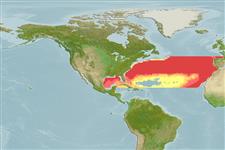Actinopterygii (ray-finned fishes) >
Stomiiformes (Lightfishes and dragonfishes) >
Stomiidae (Barbeled dragonfishes) > Melanostomiinae
Etymology: Chirostomias: Greek, cheir = hand + Greek, stoma = mouth (Ref. 45335). More on author: Regan, Trewavas.
Environment / Climate / Range
Ecology
Marine; bathypelagic; depth range ? - 500 m (Ref. 5951). Deep-water, preferred ?; 45°N - 20°N
Eastern Atlantic: Spain south to Mauritania. Western Atlantic: USA to Cuba. Northwest Atlantic: Canada (Ref. 5951).
Size / Weight / Age
Maturity: Lm ? range ? - ? cm
Max length : 20.5 cm SL male/unsexed; (Ref. 4468)
Short description
Morphology | Morphometrics
Dorsal
soft rays
(total): 18-20;
Anal
soft rays: 22 - 26. Body slender, compressed, much deeper than wide. Barbel short. Stem of barbel black or dark brown, basal portion of bulb black, terminal luminous portion and filaments yellowish. Postorbital photophore absent in males, present in males. Black, with greenish or bluish bronze iridescence on anterior parts of sides (Ref. 37473).
Mesopelagic species.
Life cycle and mating behavior
Maturity | Reproduction | Spawning | Eggs | Fecundity | Larvae
Gibbs, R.H. and M.A. Barnett, 1990. Melanostomiidae. p. 308-337. In J.C. Quero, J.C. Hureau, C. Karrer, A. Post and L. Saldanha (eds.) Check-list of the fishes of the eastern tropical Atlantic (CLOFETA). JNICT, Lisbon; SEI, Paris; and UNESCO, Paris. Vol. 1. (Ref. 4468)
IUCN Red List Status (Ref. 115185)
CITES (Ref. 94142)
Not Evaluated
Threat to humans
Harmless
Human uses
More information
Common namesSynonymsMetabolismPredatorsEcotoxicologyReproductionMaturitySpawningFecundityEggsEgg development
Age/SizeGrowthLength-weightLength-lengthLength-frequenciesMorphometricsMorphologyLarvaeLarval dynamicsRecruitmentAbundance
ReferencesAquacultureAquaculture profileStrainsGeneticsAllele frequenciesHeritabilityDiseasesProcessingMass conversion
Tools
Special reports
Download XML
Internet sources
